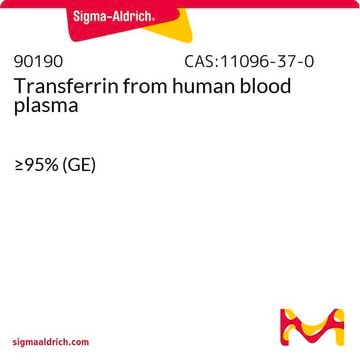T4382
apo-Transferrin human
powder, ≥98% (agarose gel electrophoresis)
Synonym(s):
Human transferrin, Siderophilin
About This Item
Recommended Products
biological source
human
Quality Level
Assay
≥98% (agarose gel electrophoresis)
form
powder
mol wt
76-81 kDa
Iron content
≤0.005%
technique(s)
cell culture | mammalian: suitable
impurities
HIV and HBsAg, source material tested negative
solubility
H2O: 50 mg/mL
UniProt accession no.
shipped in
wet ice
storage temp.
−20°C
Gene Information
human ... TF(7018)
Looking for similar products? Visit Product Comparison Guide
General description
Application
- to determine the competitive binding of bismuth to albumin and transferrin by fast performance liquid chromatography (FPLC)
- to study titanium-transferrin complex by electrochemical method
- in the preparation of transferrin solution and in the formation of conjugates with ruthenium-complexes for cellular viability studies
Biochem/physiol Actions
Other Notes
Linkage
Disclaimer
Storage Class Code
11 - Combustible Solids
WGK
WGK 3
Certificates of Analysis (COA)
Search for Certificates of Analysis (COA) by entering the products Lot/Batch Number. Lot and Batch Numbers can be found on a product’s label following the words ‘Lot’ or ‘Batch’.
Already Own This Product?
Find documentation for the products that you have recently purchased in the Document Library.
Customers Also Viewed
Articles
Understand how transferrin affects serum-free cell culture systems, crucial for biomanufacturing heterologous proteins like monoclonal antibodies.
Understand how transferrin affects serum-free cell culture systems, crucial for biomanufacturing heterologous proteins like monoclonal antibodies.
Understand how transferrin affects serum-free cell culture systems, crucial for biomanufacturing heterologous proteins like monoclonal antibodies.
Understand how transferrin affects serum-free cell culture systems, crucial for biomanufacturing heterologous proteins like monoclonal antibodies.
Our team of scientists has experience in all areas of research including Life Science, Material Science, Chemical Synthesis, Chromatography, Analytical and many others.
Contact Technical Service












